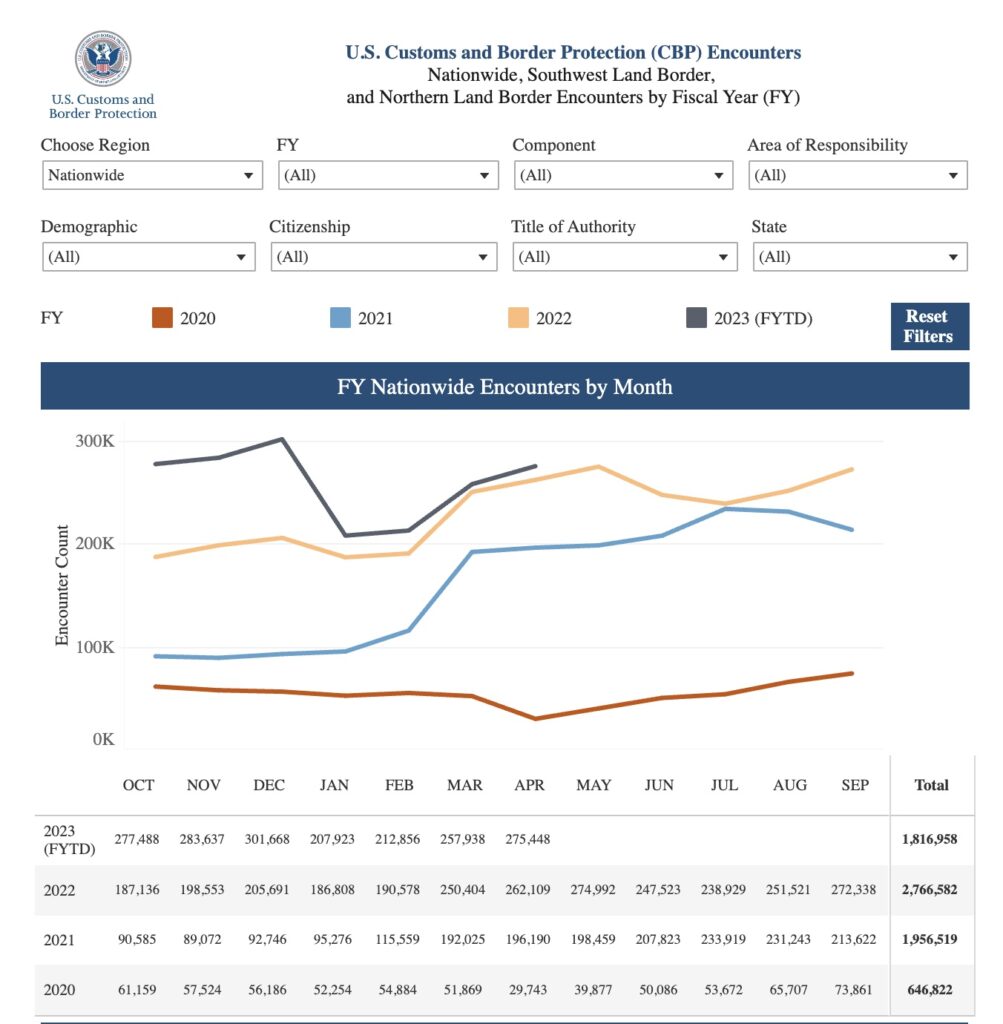
The Biden administration is celebrating a dramatic decrease of 70% in the official number of encounters with illegal aliens in the past month at the nation’s southwest border.
“As a result of planning and execution—which combined stiffer consequences for unlawful entry with a historic expansion of lawful pathways and processes—unlawful entries between ports of entry along the southwest border have decreased by more than 70% since May 11,” a recent Department of Homeland Security memo reads.
“The [Biden] administration’s plan is working as intended,” the DHS memo says.
But Mark Morgan, acting commissioner of U.S. Customs and Border Protection during the Trump administration, tells The Daily Signal that the Biden administration’s reports of “low” border encounters are “all smoke and mirrors.”
Three key reasons explain the Department of Homeland Security’s reported decline in border encounters, says Morgan, now a visiting fellow in the Border Security and Immigration Center at The Heritage Foundation. (Heritage is the parent organization of The Daily Signal.)
3 Reasons for Fewer Reported Encounters
First, Morgan says, the Biden administration is using the expiration of Title 42 on May 11 as the benchmark for encounter numbers, a time when illegal border crossing reached an all-time high.
Title 42, a public health measure originating with the Centers for Disease Control and Prevention, was put in place by the Trump administration during the COVID-19 pandemic. It allowed the Border Patrol to quickly expel some illegal aliens from the United States.
In the week leading up to the end of Title 42, the Border Patrol encountered an unprecedented 67,759 illegal aliens between the ports of entry, nearly 10,000 a day, according to Border Patrol Chief Raul Ortiz.
“We’ve never seen 10,000 a day in our lifetime,” Morgan said in a phone interview last week.
He argues that the number of border crossings seen at the end of Title 42 should not be the standard of comparison, but that the “benchmark” should be 2020.
Although Customs and Border Protection’s official May numbers haven’t been released, the numbers shared on Ortiz’s Twitter indicate that over 180,000 illegal aliens crossed the border into the U.S. between ports of entry in May, a dramatic increase from May 2020, when 21,727 illegal aliens crossed the border between ports of entry.
The rate of nearly 10,000 encounters a day was “never going to be sustained regardless of any policy, regardless of any action,” Morgan said. A point comes, he said, when the “masses” preparing to cross the border into the U.S. “are depleted because now they’ve crossed.”
The second reason for a reported decline in border encounters since the lifting of Title 42 is tied to actions take by the state of Texas, Morgan said. Gov. Greg Abbott, the Texas Department of Public Safety, and Texas National Guard worked together to send additional resources to the border to prevent illegal crossings.
Texas put National Guard troops and state troopers on the border and they “were redirecting aliens to the ports of entry,” Morgan said, which “discombobulated the cartel.” The additional resources at the U.S.-Mexico border in Texas contributed to the decline in illegal aliens crossing between ports of entry, Morgan argues.
This leads to Morgan’s third point, which he refers to as the Biden administration’s “big shell game.” The 70% decline in encounters with illegal aliens reported by DHS refers only to encounters between ports of entry.
“What they’ve done is, they simply shifted the crisis from in between the ports of entry to the ports of entry,” Morgan said.
With the end of Title 42, the Biden administration implemented a new rule to encourage migrants, in the words of DHS policy, to “avail themselves of lawful, safe, and orderly pathways into the United States, or otherwise to seek asylum or other protection in another country through which they travel, thereby reducing reliance on human smuggling networks that exploit migrants for financial gain.”
These “lawful, safe, and orderly pathways” for illegal aliens include using the CBP One application to schedule appointments at a port of entry to claim asylum. DHS says it is now scheduling up to 1,250 appointments a day for migrants to claim asylum.
A Look at the Numbers
“Through CBP One, an average of 1,070 noncitizens presented [since May 12] in a safe and orderly manner at a port of entry each day to be processed during their scheduled appointment time,” according to DHS.
If these numbers hold, in an average month, about 33,179 migrants will arrive at ports of entry for their scheduled meetings to claim asylum.
DHS reports that an average of 3,700 migrants a day still are either crossing the border illegally between ports of entry or arriving at a port without a scheduled appointment, or about 114,700 encounters a month. Migrants who arrive at a port without proper documentation to enter the country are labeled as an “inadmissible,” not an illegal entry, Morgan said.
Adding the number of migrants with scheduled appointments via CBP One to the daily average of migrants crossing illegally or presenting at a port of entry without an appointment, the monthly average becomes 147,870—about triple the monthly average at the start of 2020.

This monthly number approaching 150,000 aliens doesn’t include migrants from Cuba, Haiti, Nicaragua, and Venezuela who are being processed into America through Biden’s parole process.
In the three weeks following the end of Title 42, an “additional 23,000 vetted and sponsored Cuban, Haitian, Nicaraguan, and Venezuelan nationals arrived in the United States” through the Biden administration’s parole process, according to DHS.
In addition, U.S. Citizenship and Immigration Services has conducted “11,500 credible fear interviews” since May 12, DHS reports. “Credible fear” refers to an illegal immigrant’s fear of persecution or torture if he returns to his home country. It isn’t clear how many of these migrants have been released into the United States.
“From May 12 to June 2, DHS repatriated over 38,400 noncitizens under Title 8 authorities, including single adults and families, to more than 80 countries,” according to DHS. In that same 21-day period, using DHS averages, an additional 61,700 migrants arrived on a U.S. border, either at a port of entry or between a port.
‘Lawful Pathways’
DHS says it continues to conduct interviews with thousands of illegal aliens to assess their asylum claims “under the new Circumvention of Lawful Pathways regulation,” which requires migrants to seek asylum first in a safe, third-party country before reaching the U.S.
But Heritage’s Morgan says the exceptions to Biden’s “Lawful Pathways” rule are many.
“If you’re an unaccompanied minor or family right now, you are not being turned [away], no matter if you entered through a hundred safe, third-transit countries, it doesn’t matter,” Morgan said. “You’re still being released, even if you illegally enter.”
Single adults who fail to claim asylum in a safe, third-party country before entering the U.S. are supposed to be barred from America for five years under the Title 8 policy. But, Morgan said, if those individuals voluntarily “go back to Mexico, hook up with an NGO [nongovernmental organization], fill out the CBP One application, then go to a port of entry, [they will] be released in the United States.”
Under the Biden administration, Morgan said, “it doesn’t matter if you illegally enter in between the ports of entry, or you walk up to a port of entry, and you’re otherwise inadmissible [lacking a visa, passport, or other legal document for entry]—if you claim asylum, under this administration, you are processed and released in the United States.”
When border encounters began to rise during the previous administration, Morgan said, then-President Donald Trump declared a national emergency and implemented the ‘Remain in Mexico‘ policy.
The way to solve the border crisis, Morgan said, is to “stop releasing” illegal aliens into the country.
Have an opinion about this article? To sound off, please email letters@DailySignal.com and we’ll consider publishing your edited remarks in our regular “We Hear You” feature. Remember to include the url or headline of the article plus your name and town and/or state.

